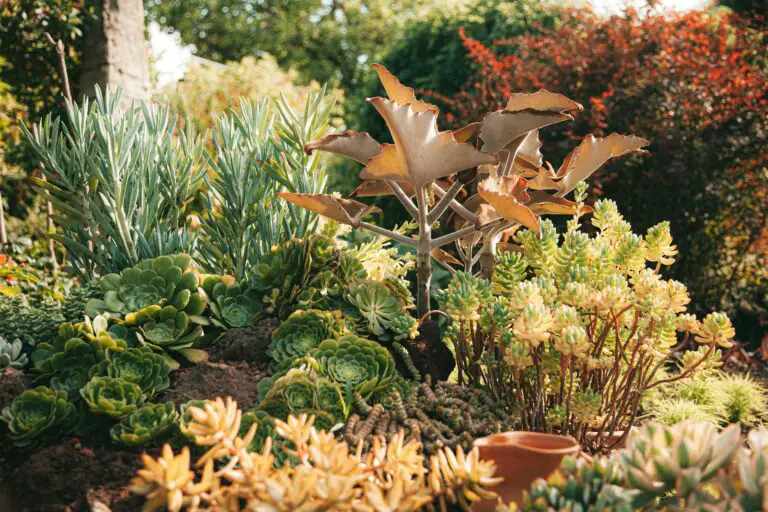Introduction to Sedum: A Succulent’s Profile
Imagine a plant that thrives with minimal effort, adds vibrant texture to your garden, and expands gracefully as the seasons go by. Meet sedum, the low-maintenance champion of the succulent world. This hardy perennial has won the hearts of gardeners and landscape artists alike, making it a commonplace yet extraordinary addition to green spaces everywhere.
Why are sedum plants celebrated in the gardening community? They come with an impressive resume: drought-resistant, a variety of forms and colors, and the ability to attract pollinators like bees and butterflies. Moreover, they’re practically made for those who adore lush gardens but possess a busy lifestyle. Before delving into the details of how big sedum can get, let’s appreciate their common uses. From rock gardens that mimic alpine environments to rooftop gardens that defy urban constraints, sedum plants are as versatile as they are dependable.
Understanding a sedum’s growth potential is crucial for garden planning. In its infancy, it may seem unassuming, but given time, some varieties can spread robustly or grow to surprising heights. This knowledge is key to ensuring that your garden remains a well-orchestrated symphony of colors and textures, rather than an unexpected cacophony. Here’s a guide that elucidates the nuances of growing sedum plants, which will aid you in harnessing their full aesthetic potential.
Now, take a glimpse at this stunning example of sedum in its elemental habitat:
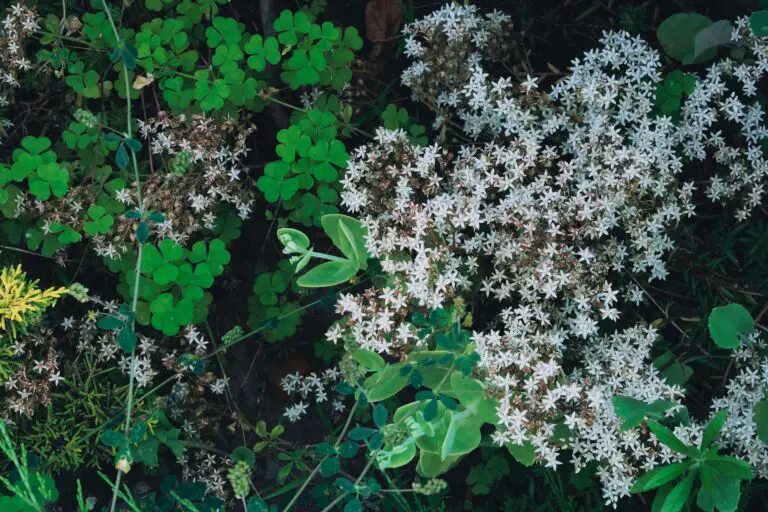
As you can see, the sedum species is more than just a plant; it’s a testament to resilience and splendor in the plant kingdom. Its ease of care does not detract from its beauty – rather, it allows even the novice gardener to cultivate a thriving garden that resonates with life and growth. Stay with us as we explore the many facets of sedum growth and learn how to make these succulent wonders a focal point in your personal oasis.
The Diversity of Sedum Species and Their Sizes
When it comes to the sedum family, there’s a world of variety that awaits. Picture, if you will, a tapestry of textures, colors, and sizes. At one end, imagine the dainty sedum ground covers that snuggle up close to the earth, spreading like a living quilt across your garden beds. On the other end, visualize the more statuesque bush-like sedums that stand tall with a burst of vibrant foliage. They’re as diverse as the landscapes they inhabit, and I’m here to take you on a tour of some of these fascinating species.
Consider the petite ‘Blue Spruce’ variety, with its needle-like leaves that create a soft ground cover no more than a few inches high. Then there’s the captivating ‘Autumn Joy’, a perennial favorite that reaches up to 24 inches in height with glorious, star-shaped blooms. But let’s not stop there! Have you heard of the ‘Dragon’s Blood’ sedum? This variety brings drama to any garden scene with its fiery red leaves and creeping habit.
Speaking of spreading, some of these charming plants really know how to make themselves at home. It’s astounding how a small plant like the ‘Gold Mound’ can grow rapidly to cover a sizable area, providing a golden carpet that enlivens your garden space. These living ground hugger’s tenacity is a wonder to behold — they require little care yet offer so much beauty. In fact, if you’re interested in the intricacies of sedum care and creating a serene space for these versatile plants,our extensive guide is packed with insights.
Now, to truly appreciate these marvels, sometimes you have to see them in action. Take a look at this informative video that beautifully showcases the variety in sedum sizes and how each brings something unique to the table—or should I say, garden!
From tiny glimmers of green at your feet to eye-catching clusters of foliage, each sedum species adds a distinctive touch to your garden story. Understanding the expansiveness of these plants can help you plan and plant a garden that’s not only beautiful but also harmonious. So whether you’re creating a rock garden masterpiece or a succulent container showstopper, sedum plants offer sizes and textures to fit any scene. Dive in and let the many sizes of sedum add depth and interest to your gardening narrative.
Understanding Sedum Growth Habits
Ah, sedum, the versatile succulents that charm gardeners worldwide with their kaleidoscope of colors and forms. But often, the question arises, “how big does sedum get?” This isn’t just green-thumb curiosity—it’s garden planning made smart! Let’s unravel the mysteries of these hardy plants and get to grips with their growing patterns.
Firstly, picture a sedum in its natural habitat, unfurling under the kiss of sunlight. These robust plants aren’t just surviving; they’re thriving—with some species sprawling expansively, while others stand compact and bijou. Sedum’s growth rate dances with the rhythm of the seasons, exploding in a lush display of foliage and flowers when the conditions are right.
But what concocts the perfect sedum scenario? Sunshine is their best bud—full sun exposure adds zest to their growth. Secondly, let’s dig into soil conditions: well-drained soil is their jam, no squelchy, waterlogged earth for these drought lovers! And don’t forget, a little touch of gardeners’ TLC goes a long way. A strategic position in the sunlight and a tiny sip of water, and boom, you’ve got a showstopper in your garden!
Take it from a friend who had a ‘little’ sedum patch that turned into a verdant sprawl reminiscent of a miniature forest; these plants surprise you! They’ve even been known to hug the edges of stone walls with their verdant embrace, cascading beautifully over the sides—talk about a green waterfall!
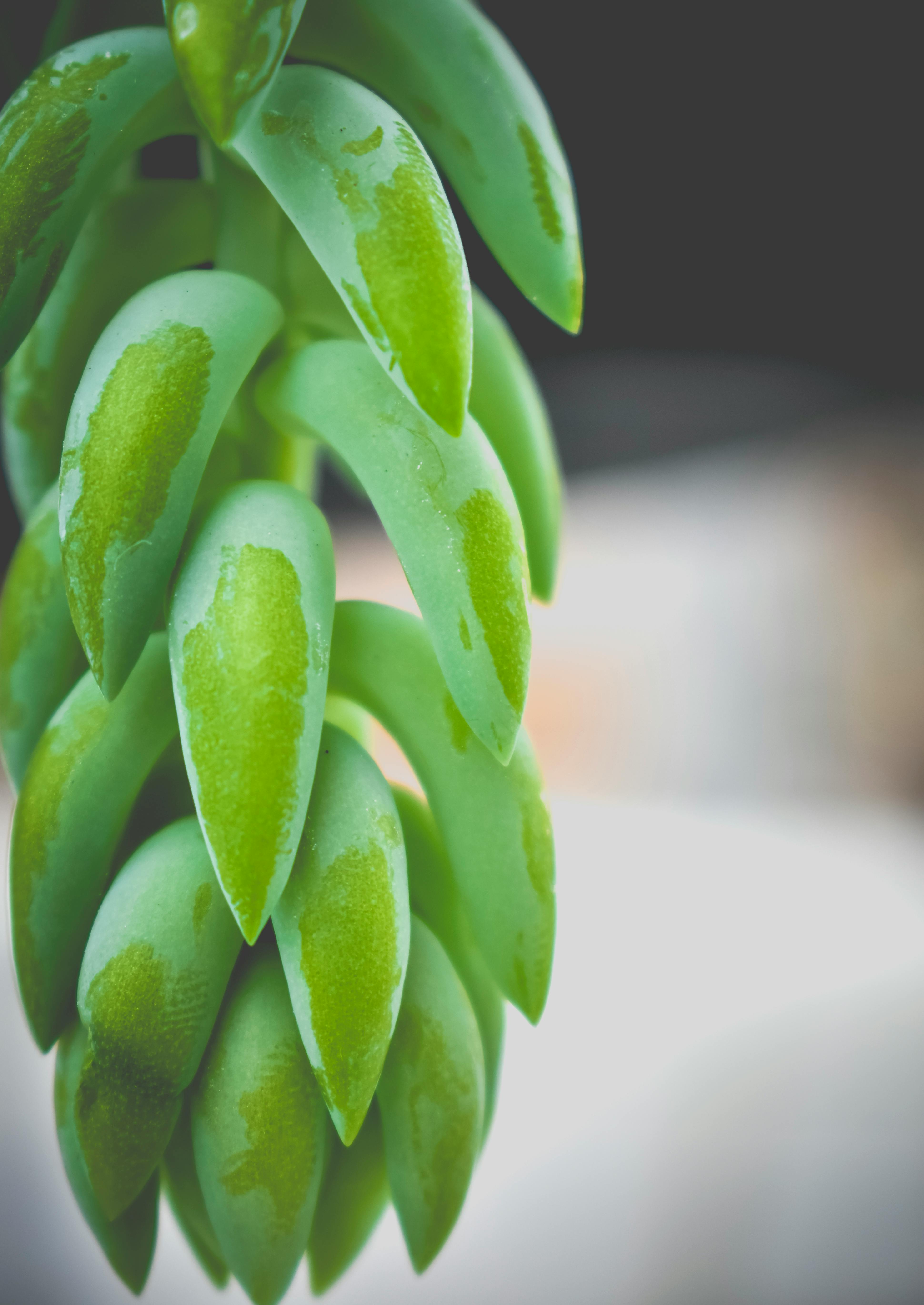
And the climate? Don’t sweat it; sedum plants are no divas. They hunker down and weather the storm, literally. Even in chillier regions, many sedum species simply take a frosty snooze then bounce back once spring hits!
Don’t just take my word for it; check out our deep dive into thriving sedum in the sun for a cornucopia of gardening treasures!
So, whether you’re plotting to plant a sedum that stays cozier than a teacup or one that sets out to conquer garden beds with vigour, you’ve got the scoop. It’s all about the sunshine, the right soil, and a touch of gardener’s instinct.
How Big Can Your Sedum Get? Setting Expectations
When we talk about sedum, also fondly known as stonecrop, you might envision those hardy groundcovers sprawling across rock gardens, or you might picture the upright, shimmering blossoms adorning autumn flower beds. Are you aware of how these steadfast plants can vary in size and form?
Sedums are incredibly versatile, with some varieties cozying up as low as 2 inches to the ground, while others stand tall at 2 feet. Picture the ever-popular ‘Goldmoss’ sedum, practically hugging the soil with its radiant yellow flowers, or the ‘Autumn Joy’ variety, reaching up to the sky with its rosy blooms. These plants know no bounds when it comes to spreading—some can fan out up to 3 feet wide!
Whether you’re a balcony gardener with pots to fill or a landscaper eyeing that sunny slope behind the house, understanding the expansiveness of sedum can help you plan. Want to maintain a tidy border or encourage a lush blanket of foliage? With the right knowledge and care—sometimes a snip here or a support there—you can guide these succulent wonders to the dimensions that fit your green dreams.
For more insights into flourishing your garden, take a peek at our article on sedum propagation for handy tips and techniques.
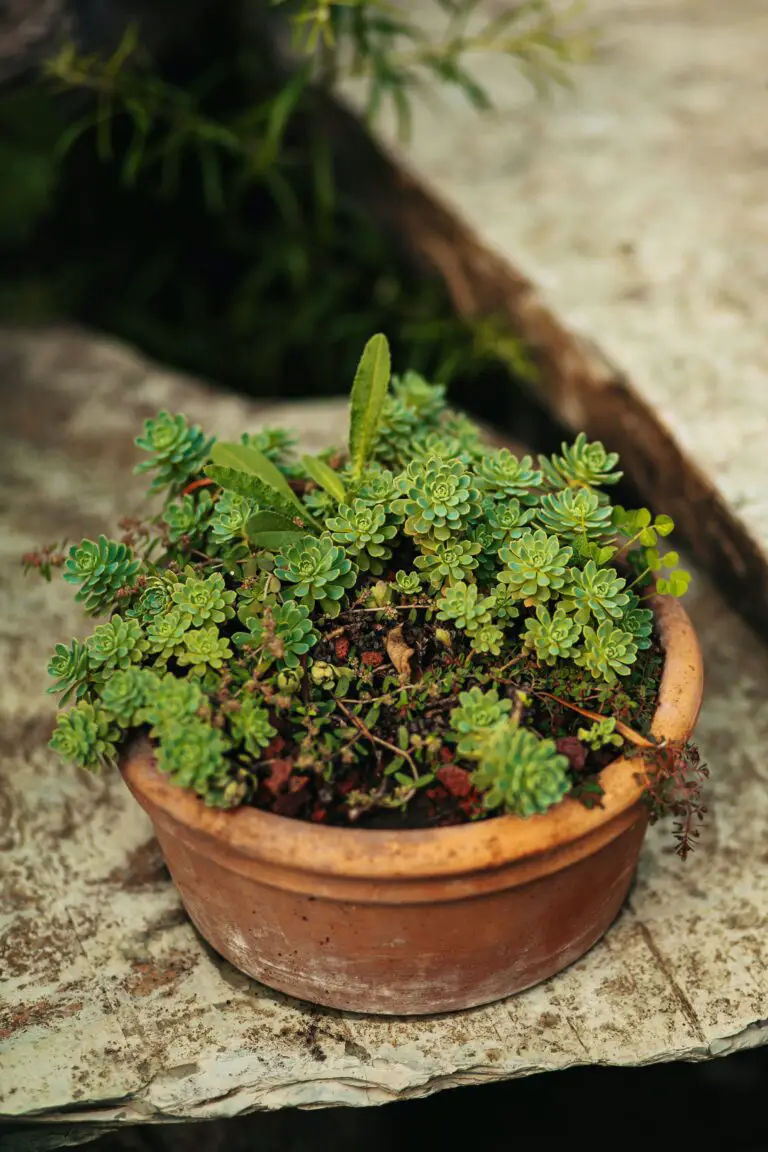
Let’s take a walk in the real world for a moment – have you ever strolled by a neighbor’s yard and noticed a striking border of sedum adorning their walkway, robust and lush despite the summer heat? Or maybe you’ve seen sedums in commercial landscaping outside buildings, showing off with vibrant foliage through the cooler months. That’s the diverse power of sedum size in action, adaptable to almost any setting or style. Curious about how to make these hardy succulents work for your space? Embrace their variability and remember: with sedums, you’re only limited by your imagination and maybe your garden shears!
Landscaping with Sedum: Smart Spacing Insights
Creating a stunning landscape often seems like a magical act, seamlessly integrating a variety of plant sizes, shapes, and colors. Among the diverse cast of garden characters, sedum plants have emerged as lead performers, owing to their adaptable nature and vibrant offerings. When it comes to sedum—affectionately known as “stonecrops”—size does matter, especially if you’re aiming for a garden that steals the show all year round!

Let’s dive into a real-life scenario: Picture a quaint cottage garden, brimming with playful sedums of varying heights, their fleshy leaves glistening under the sun’s gentle kiss. Here, the low-growing Sedum sieboldii sashays along the pathway edges, its round, glaucous leaves hugging the earth. As you gaze further, the medium-sized Sedum ‘Autumn Joy’ creates a soft, pink-hued backdrop against the cottage walls, inviting a symphony of butterflies and bees.
But how do we ensure each sedum has its solo while playing harmoniously with the garden ensemble? This is where sedum growth knowledge steps into the limelight. Sedum plants exhibit a varying range, from mere inches for ground covers like Sedum spurium, to the more grandiose two-foot spreads of taller varieties, such as Sedum spectabile.
Consider this handy tip: When plotting sedums in your landscape design, envision the maturing plants. A seemingly innocent sedum pup can expand vastly, elbowing its neighbors for space if not given enough room to flourish. By anticipating their full-grown glory, you can craft a tapestry of textures and colors that allows each plant to shine without overshadowing its companions.
Thinking about the pairing is key, too. Sedums play well with feathery grasses and perennials, like the Russian Sage or Black-eyed Susans. Imagine stepping into a garden where the upright, spiky allure of ornamental grasses is softened by the lush, spreading warmth of sedum; it’s a dynamic balance of forms that creates a truly immersive visual experience!
Encapsulating these insights, the secret to landscaping success with sedimentary superstars like sedums is to weave together plants of various heights and expanses. A smart spacing strategy ensures a garden that breathes, grows, and captivates, reflecting your keen understanding of sedum’s growth story. So, take a moment to ponder your plants, and then set the stage for a spectacular garden show that spotlights sedum in all its expansive glory!
Caring for Sedum to Promote Healthy Growth
When it comes to nurturing your sedum plants to their full glory, think of yourself as the coach of an elite botanical team. Your primary goal? To steer these versatile succulents towards their maximum growth potential and vigorous health. Let’s dive into the game plan for sedum success!
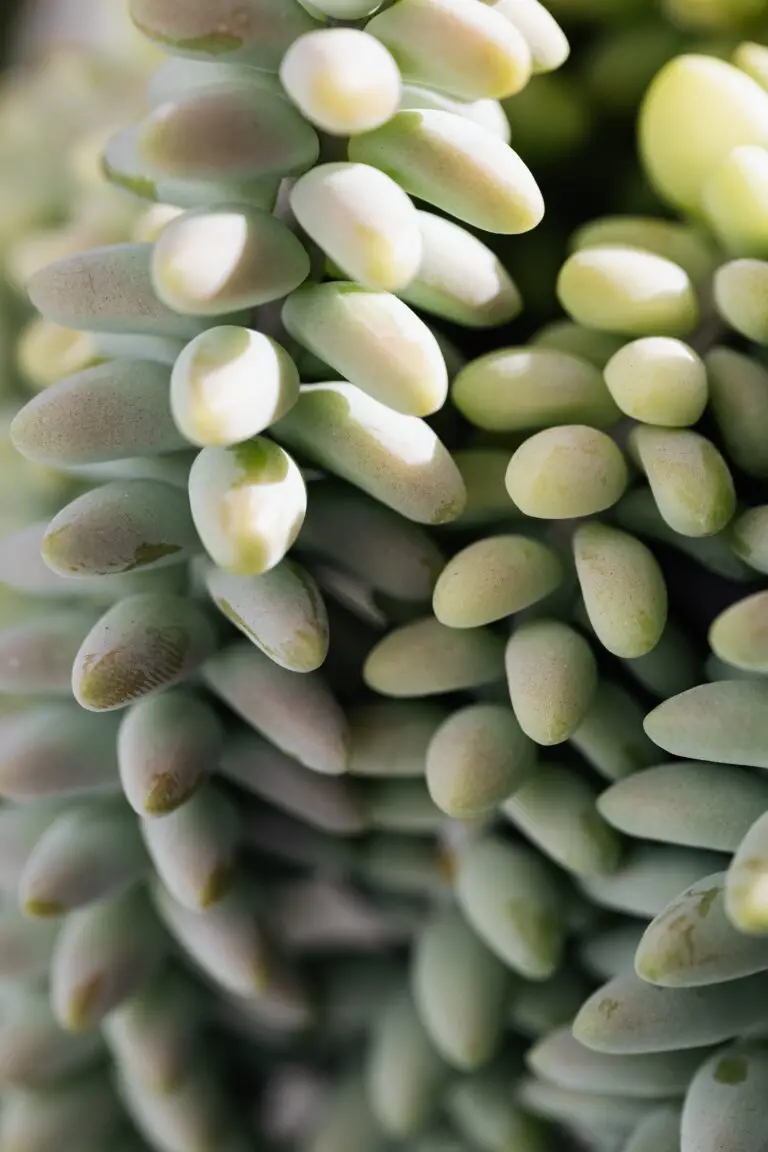
The Watering Game: Hydration without Drowning
Imagine your sedum’s roots like the feet of a marathon runner—they need a steady supply of water to stay hydrated but despise soggy shoes. The trick is to water them just enough to quench their thirst without waterlogging the soil. A good rule of thumb is to water when the topsoil feels dry. In real-life scenarios, this equates to a deep soak every couple of weeks, depending on the weather and soil drainage.
Feeding Frenzy: Nutritional Balance for Champions
A well-fed sedum is a thriving sedum. Feeding your plants with a balanced fertilizer will equip them with the nutrients needed for robust growth. Imagine hosting a banquet where the star athletes devour a balanced diet to stay in peak condition. Apply fertilizer to your plants in the spring to kickstart their growing season, much like a pre-game meal that sets the stage for success.
Pruning Practices: The Art of Sculpting Vitality
Pruning your sedum isn’t just about shaping; it’s about encouraging denser, more controlled growth. This is the horticultural version of a workout routine, designed to build strength and stamina. By snipping away dead or overgrown sections, you’re essentially coaching your sedum to grow more vigorously, just like an athlete trains to improve their performance.
Pest Control Defense: Keeping Invaders at Bay
Your sedum can face numerous opponents in the form of pests. To maintain a healthy garden, you must act as the defensive line against these unwanted critters. Use organic pest control methods to protect your sedums, creating an environment where they can grow without interference, just as a secure playing field allows athletes to focus on their game.
With these strategies in play, your sedums are set to grow big and strong, showcasing their full potential. Remember, optimal care for your sedum plants translates into a stunning display of size and health that could rival any prime athlete in the botanical world!
Frequently Asked Questions
Curious about the sizing charts in the world of sedums? Wondering if these succulent sensations will stay petite or grow to be garden giants? Well, you’re in for a treat as we unravel the mysteries of sedum sizes and their growth expansiveness!
How Big Do Sedum Plants Get?
Think of sedum plants as the chameleons of the plant kingdom—they come in a glorious array of sizes. From the tiny, desk-friendly Sedum rubrotinctum, no bigger than a teacup, to the formidable Sedum telephium, which can stretch up to two feet tall, these plants have a size for every space. Imagine a ‘Blue Spruce’ sedum covering your rock garden like a carpet of blue-green icicles, or a ‘Dragon’s Blood’ sedum spilling over the edge of a container with dramatic flair!
Rate of Growth: A Garden Sprint or Marathon?
Sedums are like the steady runners of the plant world, generally picking up pace gradually. A sedum’s sprint to maturity primarily happens during the warmer months, with some species like Sedum acre sprinting ahead and carpeting the ground at a brisk pace. On the other hand, the majestic Sedum spectabile takes its sweet time, growing methodically like a marathoner focused on the finish line.
Caring for Your Growing Giant
Tending to sedum is like nurturing a friendship—it doesn’t ask for much but rewards you generously. A sun-kissed spot, well-drained soil, and occasional water are the keys to a happy sedum. Picture your sedum thriving with plump leaves and bright blooms, a true testament to minimal care yielding maximum beauty.
Still thirsting for more knowledge about these versatile beauties? Check out this video where avid gardeners share their wisdom and demonstrate the immense potential of sedum size and growth:
So whether you’re contemplating a petite patch or an expansive garden tapestry, sedum plants adjustable in size will surely fit the bill. Just remember to give them love, light, and a little room to grow!
Can Different Sedum Varieties Crossbreed to Affect Size?
When we think of the sedums dotting our gardens and containers, it’s like a miniature world of sculptural beauty. But what happens when we play matchmaker in the sedum world? Can different varieties of sedum crossbreed, and does this tango of traits affect their size? Let’s dive into the genetics garden party and see the potential for scaling up or down in the whimsical world of sedums.
It’s as though sedums exchange secret handshakes beneath the soil. Crossbreeding in sedums is not just possible; it’s like a botanical bash where genes dance and mingle. This genetic get-together opens the door to a profusion of possibilities, influencing the size, color, and resilience of the offspring. Imagine a ‘Goldilocks’ scenario where two distinct sedum parents give rise to a hybrid that’s ‘just right’ for your garden expectations.
Let’s talk real life for a second. You’ve got ‘Sedum spectabile’, stretching up to a proud 18 inches, while ‘Sedum acre’ snugs close to the earth. When crossbreeding occurs, the resulting hybrid could land anywhere between its loftier and its more ground-hugging parent. This fascinating genetic canvas allows gardeners to curate their green space with precision, dialing in the desired height and spread of their sedum collections.
But how does this happen? Pollen from one sedum variety finds its way—courtesy of the wind or a helpful bee—to the receptive flower of another variety. The outcome, if successful, is a hybrid that carries the genetic blueprint from both parents. People have stumbled upon serendipitous sedum hybrids, while others intentionally create new varieties, dreaming of a standout sedum star.
Consider the case of a gardener who noticed that two distinct sedum species, which usually wouldn’t mingle, produced an accidental offspring. This hybrid ended up thriving in a spot where neither parent had. It exhibited a robustness against pests and a unique size that made it the showstopper of the succulent collection.
This crossbreeding potential encourages gardeners and breeders alike to imagine and craft an ever-expanding portfolio of sedum varieties, exploring the breadth and depth of traits that contribute to our aesthetic and practical enjoyment. So, could the next sedum in your garden be a towering giant or a petite marvel? Only the dance of genetics will tell.
For a visual exploration of how plant varieties can be influenced by crossbreeding, let’s check out this insightful video:
As we witness the interplay of size and genetics in the realm of sedums, we’re reminded of nature’s endless creativity. It’s not just about how big a sedum can grow; it’s about the diversity and adaptability that crossbreeding endows upon these resilient plants, making our green spaces all the more dynamic and personalized.
How to Handle Sedum That Grows Too Large or Too Fast?
Sometimes, sedum plants, known for their hardiness and easygoing nature, transform into botanical behemoths that defy our garden layouts. So what do you do when your sedum turns into a giant green goliath bursting at the seams of your carefully designed space?
Prune with Precision
The first line of defense against an overeager sedum is to wield your shears strategically. Pruning not only reigns in their expansiveness but can also encourage denser growth. It’s like giving your plant a haircut to ensure it looks good while keeping it manageable. Picture the sedum that started as a modest guest at your garden party and suddenly started hogging all the hors d’oeuvres – a little trim can remind it of its manners.

Divide and Conquer
Dividing your sedum can feel like an act of botanical multiplication – you take one large plant and create two or more new ones. This approach not only curbs the size but can also rejuvenate older plants that may begin to show a bald spot or two, much like thinning hair. Imagine turning one towering plant into a supportive plant community, each with enough personal space to thrive.
Relocate for Room to Grow
When your sedum aspirations outgrow their current residence, it may be time to consider relocation. Transplanting portions of your plant to a new area can allow all sections to flourish. It’s akin to finding a new home with a bigger yard for a rapidly growing puppy – the extra space means more room to play and grow.
Adapt Your Garden Layout
Lastly, sometimes the sedum is simply telling you it’s time for a garden layout shake-up. What may have started as a small succulent corner can evolve into a sedum-centric landscape design. Embrace the change—let the plump leaves and intricate blooms of these enthusiastic growers take center stage and set the scene for a dramatic green display.
Whether you prune, divide, or let it ride, managing an overgrown sedum is an exercise in garden flexibility. Keep these tips in mind, and your green giants will be the talk of the town—just make sure they don’t grow large enough to become the town itself!
Does Trimming Sedum Affect Its Eventual Size?
When it comes to cultivating sedum, gardeners often ponder the effect of trimming on the plant’s final stature. The truth is, a strategic snip here and there doesn’t just reshape the plant; it can also influence its ultimate dimensions. A sedum, left to its own devices, may stretch out lavishly, like a guest lounging comfortably across a garden bench. However, introduce pruning shears into the mix, and you can nudge it towards a more compact, denser form. It’s rather akin to guiding a child’s growth through gentle encouragement rather than let them sprawl out on the couch with snacks.
Consider the robust ‘Autumn Joy’ variety, which without trimming, can rise to a mighty two feet or more, its heady blooms waving like flags at a parade. A timely trim, however, can redirect energy, causing it to bulk up rather than shoot up, and thus deter that late summer flop when the stems bow under the weight of mature flowers. If you’ve ever seen these sedum heads drooping after a storm, you’ll know exactly how timely intervention could have spared them from tumbling over like dominoes.
It’s not just height we’re talking about, but also spread. Trimming can help contain the ambitious expanse of ground-hugging types, like the enthusiastic ‘Dragon’s Blood’, which otherwise might sprawl greedily over rocks and neighboring plants. A thoughtful cut can keep it neatly within its garden plot, much like a well-kept hedge that knows the polite boundaries of its own yard.
The art of trimming sedum isn’t just guesswork; it’s a horticultural strategy underpinned by timing and technique. Springtime sees gardeners pinching back new growth by half to promote bushier plants, a technique reminiscent of pinching a child’s cheeks to coax out a giggle, resulting in a more joyful garden presence. Similarly, the ‘Chelsea chop’, executed late in the spring for taller varieties, reduces height and delays blooming for a more controlled display akin to scheduling fireworks for the grand finale.
Just as a sculptor chisels away at marble, a gardener wields pruning shears to reveal the sedum’s final form. The secret lies in understanding that tidy, precise cuts can manifest a landscape masterpiece – or at the very least, a charming garden vignette. So, as you contemplate the shears in your hand, remember that every snip steers your sedum towards its best self, shaping not just its physical presence but its journey through the seasons.
Seeking visual inspiration? Behold the vibrant charm of expertly pruned sedums:
